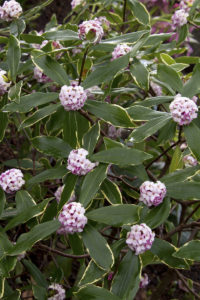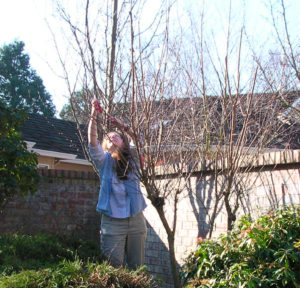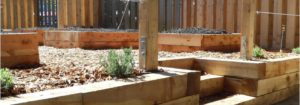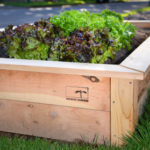Portland Rain Garden Plants with Year Round Color
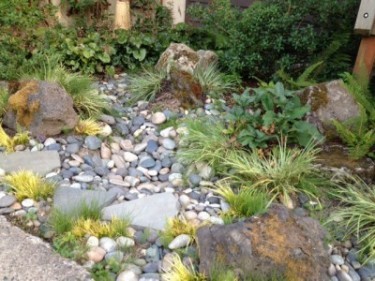
Downspout disconnect rain garden in Raleigh Hills. Designed by Carol Lindsay and D & J Landscape Contracting
As a Portland landscape designer I like my rain garden designs to have year round color. Many Portlanders have rain gardens in the front yard so it’s important to have year round color. Without careful plant selection rain garden plantings can look forlorn in the winter months with no leaves or color present. I love a good hit of color to offset our typically gray winter season.
To select plants for a rain garden I start by thinking about the areas of a rain garden that have different degrees of wetness. There are fewer evergreen plants that work well in the wettest areas and a wider range of plants for the sides and the top which are less wet. Knowing which plants will thrive in this situation ensures I select the right plant for the right place.
Rain Garden Planting Design in Raleigh Hills, Portland, Oregon
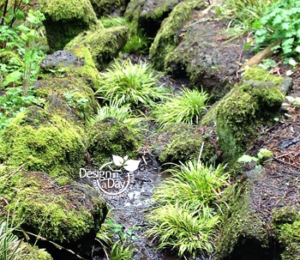 Plantings used: Miniature Golden Sweet Flag is a 4″ tall chartreuse evergreen blade. Use the Latin name, Acorus gramineus ‘Minimus Pusillus Aurea’, to get the right plant. The evergreen narrow gold tufts form a somewhat flattened pinwheel which adds interesting texture. It will take standing water that drains away so it’s perfect for the wettest areas of a rain garden. If the area is a lake for a week at a time, that is too wet. Miniature Sweet Flag is unique because it also thrives in dryer sunny areas. I don’t use it in heavy shade designs.
Plantings used: Miniature Golden Sweet Flag is a 4″ tall chartreuse evergreen blade. Use the Latin name, Acorus gramineus ‘Minimus Pusillus Aurea’, to get the right plant. The evergreen narrow gold tufts form a somewhat flattened pinwheel which adds interesting texture. It will take standing water that drains away so it’s perfect for the wettest areas of a rain garden. If the area is a lake for a week at a time, that is too wet. Miniature Sweet Flag is unique because it also thrives in dryer sunny areas. I don’t use it in heavy shade designs.
False Bugbane – Beesia deltophylla has glossy evergreen heart shaped leaves. It’s a perfect companion plant for the narrow blades of the Miniature Gold Sweet Flag; together they make a perfect year round color combination. The Beesia would die planted in the lowest wettest area so I plant it above the Golden Sweet Flag in a rain garden.
Designers know Compact Inkberry Holly – Ilex Glabra ‘Compacta’, will survive temporary standing water but there are few if any other choices for the Pacific Northwest. I’ve used Compact Inkberry Holly, on the sides of a rain garden. It works as a house foundation planting too. Don’t be fooled by the word “compacta”. It will happily grow to 4′ tall. Fortunately you can prune this shrub once or twice a year and keep it 2’ by 2’.
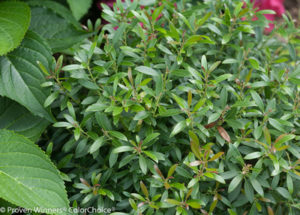
Ilex Glabra (Inkberry) is a great plant for rain gardens because it is evergreen. Few wet tolerant plants are evergreen. Photo from Proven Winners
Not convinced about wet soil and evergreen shrubs? I will restrain myself to listing just 5 evergreen that die a sad little death in overly wet winter soil: Azaleas, Escollonia, Pieris, Rhododendron, and a variety of conifers to include expensive little dwarf Hemlocks. Ouch!
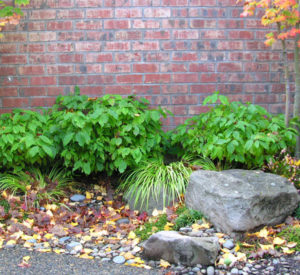
New rain garden design gets rid of the winter lake in this entry courtyard. My client built it herself.
Portland Courtyard Rain Garden Planting Design
A winter lake flooded this small entry courtyard every year for weeks at a time. My client installed her own rock and plantings from my design but had the pipe that carried away the water installed by professionals. After the rain garden was installed we added two vine maple on either side. The vine maple trees on either side of the rain garden would be dead instead of showing their glorious fall color. Vine maple hate poor drainage and prove it by promptly dying.
Dwarf 16″ tall red twig dogwood “shrublets” Cornus Sericea ‘Kelseyi’ and a 12″ tall Golden Sweet Flag called Acorus gramineus ‘Aurea’ adds interest and year round color.
Get the Right Plant for Your Rain Garden
Lots of people love red twig dogwood. It’s a great plant for year round color and its important to get the right plant!
Some varieties of dwarf red twig dogwood get 6′ tall. Other red twig dogwood can get 15′ tall. Cornus sericea ‘Kelseyi’ is 12″ to 18″ tall. This dwarf dogwood variety has short colorful red twigs in winter but can get unattractive fungal leaf spots in spring. I don’t know of a dwarf variety of red twig dogwood that is free from spring fungal leaf spots. It’s a very useful plant. Life is too short for spraying plants with chemicals and really dear reader, who has time to intelligently apply fungicides?
NW Portland Hillside Rain Garden Plantings
This hillside garden was designed to be seen from the master bedroom. There is a lot of water that moves through this hillside so it has a dry stream bed to collect the water with a drain at the bottom. It doesn’t have any plants inside the winter water area so I don’t consider it a true rain garden. The plants were installed behind a low retaining wall which is hidden by the plants foliage which spills over the walls. These clients are gardeners so I use a wider variety of plantings for their design than I would for non gardeners. Ferns carry the garden for 9 months of the year. Evergreens such as native Oregon Oxalis – Oxalis organa, Japanese Soloman’s Seal Polygonatum Falcatum (evergreen Soloman’s Seal), Hardy Geranium – Geranium Macrorrhizum and Carex grass provide year round color. Toad Lilly – Tricyrtis hirta, provides exotic color in the fall. Out of all these plantings only the Carex grass can handle excessively wet winter soil. See more about this NW Portland Natural style Landscape.
Portland Industrial Modern Style Rain Garden
Landscape Designer Barb Hilty designed this rain garden using no plants at all. The full season interest relies on the ornamental rain chain, the shape of the steel boxes and the black rock to carry the day year round and allow this home owner to disconnect the downspouts in style.
Contact us
We love to work with Portland rain gardens and naturalistic dry stream beds as part of an overall design for your property. Contact us for a collaborative approach. The best design comes from talking at the kitchen table.

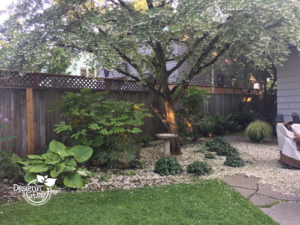
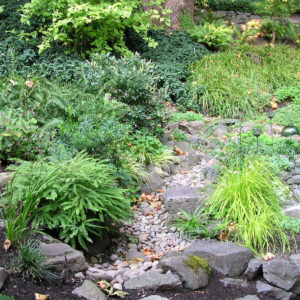
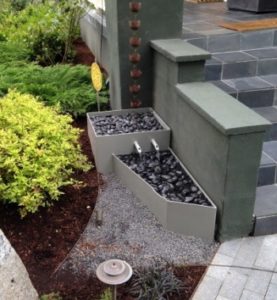

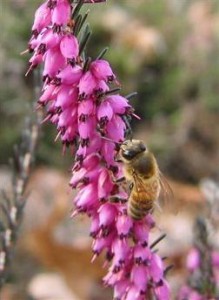
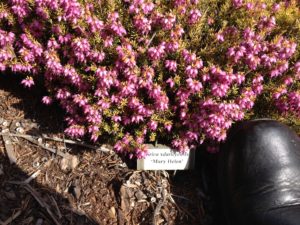
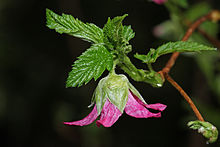
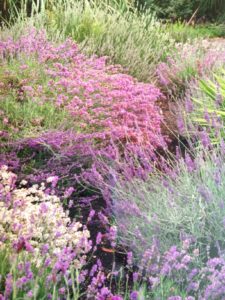
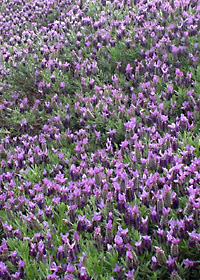
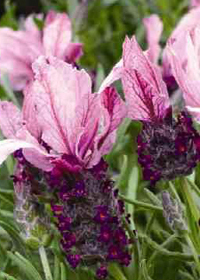
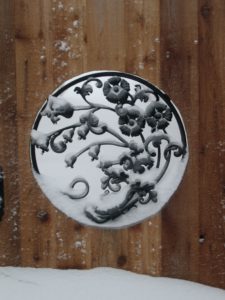 I recently was a guest on a radio talk show, Real Estate Today, with
I recently was a guest on a radio talk show, Real Estate Today, with 